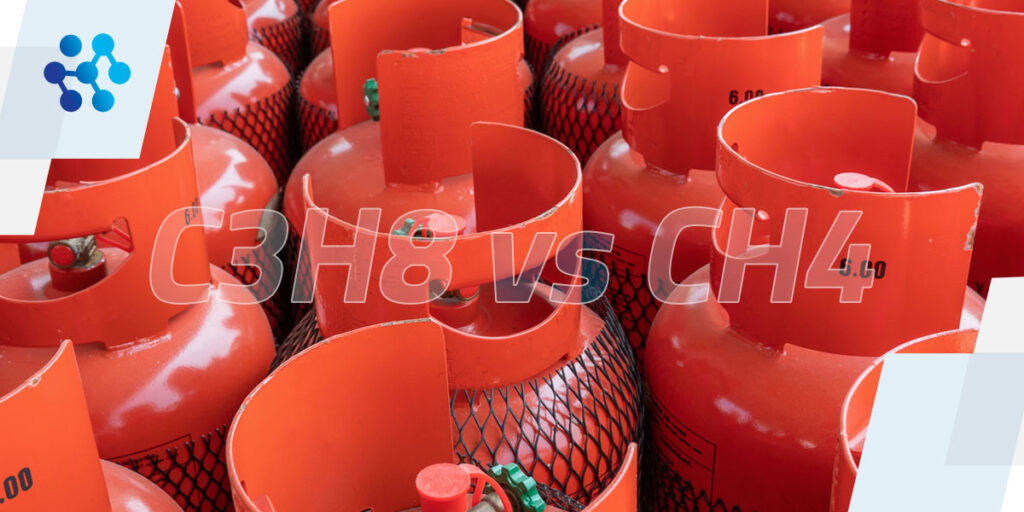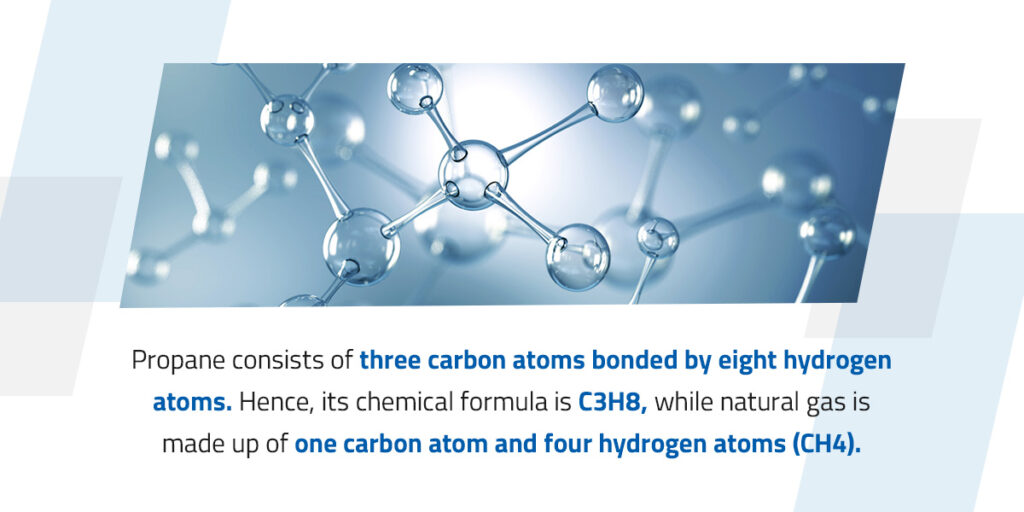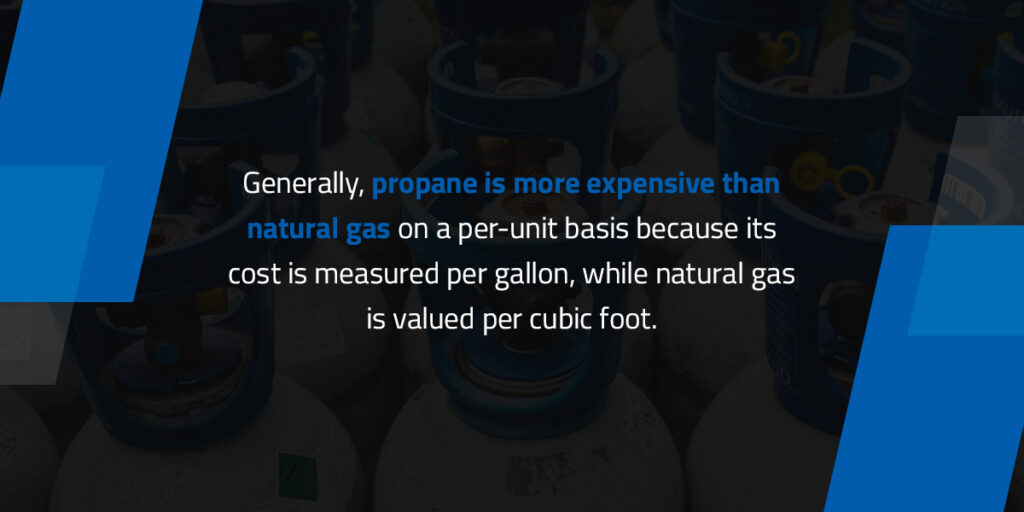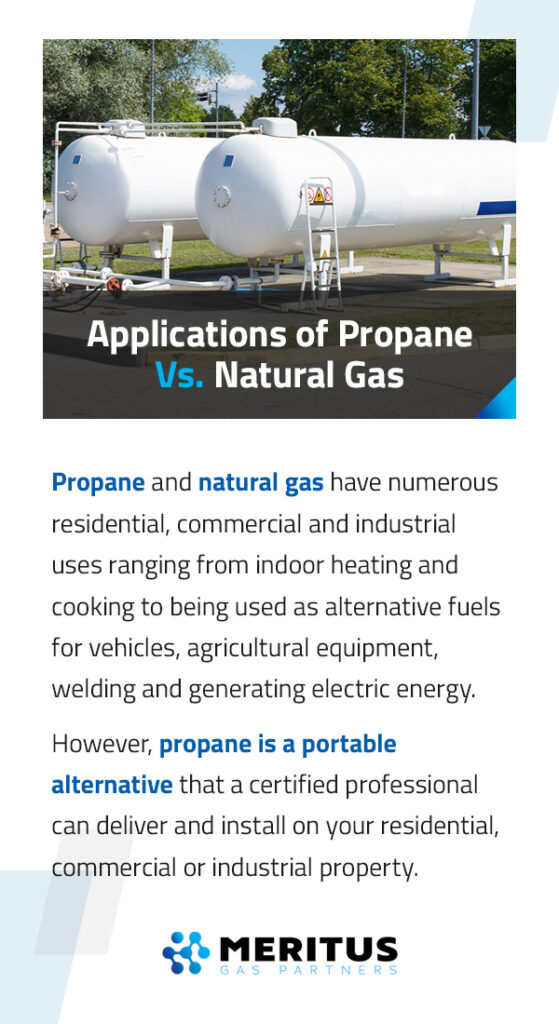

Propane and natural gas are locally produced fossil fuels. Both are colorless, odorless, clean-burning and cost-effective alternatives to electricity. They may be used interchangeably for a variety of residential, commercial and industrial applications ranging from heating homes, cooking, water heating and powering appliances, machinery and vehicles.
While they have many similarities, they also differ, including their chemical composition, energy efficiency and storage and distribution methods. Below are the main factors that distinguish propane and natural gas so you can make the right choice for your home, business or industrial use.
Propane is a clean, colorless and odorless fossil fuel that’s compressed and stored in liquid form. In this state, it’s also referred to as liquified petroleum gas (LPG) or LP gas.
It’s a byproduct of natural gas that’s extracted through refrigeration. It can also be processed from crude oil through distillation. While it’s virtually odorless, an odorant called ethyl mercaptan is typically added after extraction to give it a skunk or rotten egg smell that makes it easy to identify gas leaks.
Propane accounts for up to 2% of the total energy consumption in the U.S. Its most common uses include household use like cooking and water and home heating. It’s also used to power industrial machinery, cut metal, produce plastic and run agricultural equipment.
Natural gas is a combustible, colorless, odorless and nonrenewable gaseous fossil fuel. It’s a combination of hydrocarbons. Like propane, odorants are added to help with gas leak detection. It makes up at least 40% of total utility energy consumption in the U.S.
As a fossil fuel, natural gas is obtained from sedimentary rocks, like shale. These rocks form from the remains of plants and animals combined by heat and pressure over millions of years into an oxygen-deprived gaseous substance found near coal and oil deposits. There are two main categories of natural gas based on their origin and location:
Shop Gas From a Partner Near You
While propane and natural gas share numerous similarities and are used for many of the same applications, they also differ in composition, infrastructure and storage, cost, efficiency and environmental impact.

The chemical compositions of propane and natural gas are very distinct. Propane consists of three carbon atoms bonded by eight hydrogen atoms. Hence, its chemical formula is C3H8, while natural gas is made up of one carbon atom and four hydrogen atoms (CH4).
Propane’s chemical composition ensures it can exist in gaseous form at room temperature or when the atmospheric pressure doesn’t exceed (14.6 psi). At higher pressures of between 100 and 200 psi, propane condenses and exists in a liquid state. It has a high octane rating and calorific value, meaning it works great for spark-ignited internal combustion engines and produces more energy than natural gas.
Generally, natural gas includes hydrocarbons — highly combustible organic compounds found in fossil fuels — and non-hydrocarbons — acid gases that are considered impurities in fossil fuels.
When it is extracted, natural gas is usually wet because of the hydrocarbons, which include ethane, butane, propane and pentane and the nonhydrocarbons, such as CO2 and water vapor. These wet ingredients must be removed during processing to produce pure natural gas that consists of almost pure methane (60-90%). The hydrocarbons or natural gas liquids (NGLs) are not disposed of. Instead, they’re sold as valuable natural gas byproducts.
One of the most profound differences between propane and natural gas is their transportation and storage methods, which are determined by their natural state.
After processing, propane is pressurized and compressed into a liquid that’s stored in underground pipelines with controlled conditions at production and distribution sites. Propane is more portable than natural gas because the compressed liquid is distributed through a network of pipelines, barges, tractor-trailers, railcars and tanker trucks.
Propane is stored in lightweight pressurized tanks made of steel and other corrosion-resistant materials that vary in size based on application. Tank sizes range between 100 to 1,000 gallons for residential tanks and 1,000 to 30,000 gallons for commercial and residential tanks, which can be under or above ground. These tanks have a pressure valve that releases the pressure and converts propane back into its gaseous state to facilitate residential, commercial and industrial uses.
Propane’s portability makes it highly reliable because even in extreme weather, propane tanks can continue delivering heat to power homes and facilitate its other uses.
Natural gas is transported through an extensive and complex network of underground pipelines. These pipelines facilitate its collection for processing, storage and delivery to the end consumer. They can be categorized into three types:
Pipelines are made of either strong carbon steel materials or highly advanced plastics that don’t corrode easily. Hard plastic is preferred for pipelines that require easy replacement and flexibility.
Compressed natural gas (CNG) is highly pressurized during transportation, and compressor stations powered by motors, engines or turbines are strategically placed along the pipelines to maintain that pressure. Pipelines also have metering stations to detect leaks while monitoring flow and pressure changes. Natural gas can also be stored in its uncompressed state under extremely cold temperatures for niche applications.

Because these two are fossil fuels, their prices fluctuate over time to meet supply and demand. Generally, propane is more expensive than natural gas on a per-unit basis because its cost is measured per gallon, while natural gas is valued per cubic foot.
Hence, natural gas is cheaper per unit of energy than propane. However, propane has a higher energy content per cubic foot, with approximately 2,500 British Thermal Units (BTUs) per cubic foot. Natural gas only produces approximately 1,000 BTUs per cubic foot. This means you need to purchase twice the amount of natural gas to produce the same amount of heat as propane.
BTU is a measure of heat produced by fuels or energy sources. It represents the heat required to increase the temperature of 1 pound of water by 1 degree Fahrenheit. While propane may cost more per unit, it burns cleaner and boasts more heating efficiency.
Propane and natural gas are generally considered clean-burning fuels with a low environmental impact. Propane has a significantly lower carbon content than other fossil fuels and petroleum products like gasoline and diesel. When combusted, propane produces only about 12.61 pounds of CO2, almost half of what gasoline emits. Substituting propane for other fuels, such as coal, also minimizes the emission of air pollutants like carbon monoxide and nitrogen oxide.
In case of leaks, propane does not build up in soil or water, a common environmental hazard of many fossil fuels. Propane’s high heat efficiency also ensures less energy is used to power appliances.
Natural gas is a relatively clean burning fuel that does not leave ash or toxic mercury or sulfur oxide emissions. However, methane in natural gas is a highly potent greenhouse gas that releases CO2 and water vapor when combusted. Fortunately, these emissions remain to be significantly lower than those produced by burning coal and petroleum products.
Natural gas may contribute to environmental pollution when it leaks into soil, water and the atmosphere. These leaks are often a result of drilling accidents, pipeline leaks and abandoned gas wells. Strict industry standards and federal regulations are in place to minimize leaks and ensure safe processing, storage, distribution and use of natural gas.

Propane and natural gas have numerous residential, commercial and industrial uses ranging from indoor heating and cooking to being used as alternative fuels for vehicles, agricultural equipment, welding and generating electric energy. The difference in performance in all the applications is negligible, and the choice typically comes down to your location because natural gas utility pipelines are not available everywhere.
However, propane is a portable alternative that a certified professional can deliver and install on your residential, commercial or industrial property. Switching between the two fossil fuel options is generally an investment because they need different equipment and accessories to facilitate the pressure differences, but the changes can prove beneficial. Some of the appliance modifications that may be necessary include burners, conversion kits and regulators.
Compressed propane and natural gas versions can be used as alternative automobile fuels. LPG and propane autogas are among the top transportation fuels thanks to their high-octane rating that makes them ideal for powering spark-ignited combustion automobile engines. Compressed natural gas or liquified natural gas are relatively affordable alternatives to gasoline and diesel. However, these vehicles may be expensive because they need large, heavy and insulated tanks due to the dense nature and cold storage temperatures required.
Propane is also ideal for use in the welding industry thanks to its high combustion temperature of 3,596 F. This means it can be used to melt metals such as brass, bronze and aluminum, as well as metal jewelry like silver and gold.
Here are some of our most frequently asked questions to help you decide which gas is right for your application:
Propane is generally better because it’s a clean-burning fuel that’s more energy-efficient than natural gas. It’s also a low-emission fuel that’s better for the environment because it produces fewer greenhouse gases and air pollutants.
Propane is relatively safe, nontoxic and reliable for indoor and outdoor use. Contrary to popular belief, propane tank explosions are not common, provided you follow all safe handling and storage instructions.
One of the main disadvantages of propane is the logistics for transporting it. While with natural gas, you only need to pay your utility bill to keep it on, scheduling for propane tank refills may be time-consuming unless you find a reliable supplier who’ll refill your tank when you need it. Even with a reliable supplier, supply chain and transportation issues can sometimes prevent it from getting to you on time. Propane prices also fluctuate based on market trends, weather conditions and supply and demand.
Natural gas is nonrenewable, meaning it’s not a sustainable energy source because its supply will eventually deplete. It also contributes to the emission of greenhouse gases and can be toxic to humans when it’s inhaled in large quantities in case of leaks.
Propane gas is more flammable than natural gas, meaning it is more susceptible to causing injuries and accidents when you don’t implement strict handling, storage and usage precautions. However, propane is not flammable when pressurized in its liquid state.
Propane is preferable for residential use because it’s convenient, versatile and cost-effective. Its low carbon footprint and greenhouse gas emissions also appeal to many homeowners. Either option may prove more affordable for your home depending on the current market prices, your location, frequency of use and delivery and how much gas you typically consume in a given period.

Meritus Gas partners with independent gas and welding equipment suppliers to provide you with high-quality gases, welding and cutting products. Some of our partners, like Ozarc Gas, can supply you with propane for residential, commercial, industrial and agricultural applications. They also offer comprehensive support services, ranging from affordable propane tank purchasing and leasing options to professional propane tank installation, around-the-clock delivery and servicing.
Hohenschild is another one of our partners that supplies gas equipment necessary when switching from natural gas to propane. Their selection of products includes flow meters, monitors and regulators needed for transmitting LPG. You can rely on our partners to reliably deliver propane for all your applications. Contact us today or request a solution to get customized gas and welding supply solutions that meet your needs and budget.